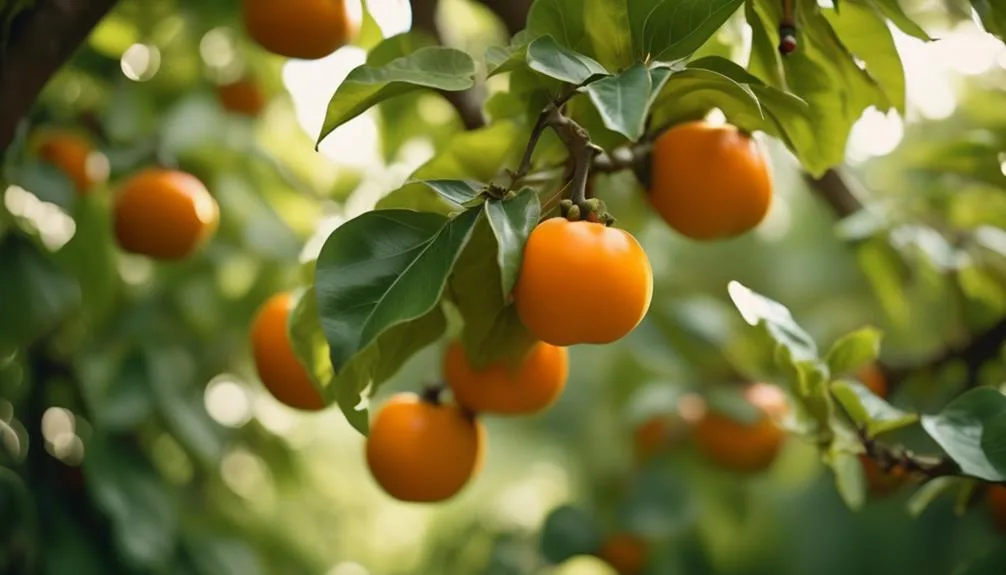The United States leads in persimmon production, with over 23,000 acres of persimmon trees.
But where do these trees grow best? Understanding the ideal conditions for persimmon tree growth is important for cultivation.
It's not just about the climate or soil. So, where do persimmon trees thrive?
Let's explore the factors that contribute to their optimal growth and production.
Key Takeaways
- Persimmon trees can thrive in a range of climates, making them suitable for various regions.
- They prefer moderate temperatures between 60 and 70 degrees Fahrenheit and are sensitive to extreme cold and heat.
- Persimmon trees have a good tolerance for humidity, making them suitable for coastal areas and inland locations.
- Adequate air circulation and well-drained, loamy soil are important for the successful growth of persimmon trees.
Climate Requirements
To grow persimmon trees successfully, you need to consider the climate requirements in your specific location. Persimmon trees thrive in moderate temperatures, ideally between 60 and 70 degrees Fahrenheit, making them adaptable to a range of climates. However, they're sensitive to extreme cold and heat, so it's crucial to ensure they're protected from harsh conditions.
Additionally, persimmon trees have a good tolerance for humidity, making them suitable for various regions, from coastal areas to more inland locations. They can withstand moderately high humidity levels, but it's important to ensure adequate air circulation to prevent issues such as fungal diseases.
Understanding the temperature preferences and humidity tolerance of persimmon trees is essential for creating an optimal environment for their growth and fruit production.
Soil Conditions
Considering the ideal climate requirements for persimmon trees, the next crucial factor to examine is the soil conditions in which these trees thrive. Persimmon trees prefer well-drained, loamy soil with a slightly acidic to neutral pH level ranging from 6.0 to 7.5.
Here are some essential points to consider:
- Soil Type: Persimmon trees thrive in loamy soil, which provides good drainage while retaining enough moisture for healthy growth.
- pH Levels: The optimal pH level for persimmon trees ranges from 6.0 to 7.5, ensuring that the soil is slightly acidic to neutral, promoting nutrient uptake.
- Fertilizer Options: Consider using a balanced fertilizer with an N-P-K ratio of 10-10-10 or 8-8-8 to provide essential nutrients for healthy growth and fruit production.
Understanding these soil conditions and providing the right fertilizer options is crucial for ensuring the successful growth of persimmon trees.
Sunlight Needs
In order to thrive, persimmon trees require ample sunlight throughout the day to support their growth and fruit production. Optimal conditions for persimmon trees include at least 6-8 hours of direct sunlight daily.
During the growing season, it's crucial for the trees to receive consistent sunlight to promote healthy foliage, flowering, and fruit development. Seasonal changes also play a role in meeting the sunlight needs of persimmon trees.
In the spring and summer, when the trees are actively growing and fruiting, they require the most sunlight. During fall and winter, when the trees are dormant, sunlight is still beneficial but not as critical.
Ensuring that persimmon trees have access to the right amount of sunlight throughout the year is essential for a successful harvest and overall tree health.
Watering and Drainage
When cultivating persimmon trees, ensuring proper watering and effective drainage is essential for their health and productivity.
- Root Development:
Adequate watering is crucial for encouraging deep root development in persimmon trees. Deep roots help the tree withstand drought conditions and absorb essential nutrients from the soil.
- Irrigation Techniques:
Drip irrigation systems are highly recommended for persimmon trees as they deliver water directly to the root zone, minimizing water waste and reducing the risk of foliar diseases. Mulching around the base of the tree helps retain soil moisture and prevents water runoff, promoting healthy root growth.
Proper watering and drainage not only support the current health of the persimmon tree, but they also contribute to its long-term vitality and fruit production.
Geographic Regions
To understand how persimmon trees thrive in different geographic regions, it's important to recognize how their root development and irrigation needs adapt to varying environmental conditions.
Persimmon trees are adaptable and can grow in diverse climates, from the southern United States to regions in Asia. They flourish in temperate climates and are particularly well-suited to areas with distinct seasons and moderate rainfall. The trees require a chilling period during the winter to set fruit, making them ideal for regions with defined growing seasons.
Additionally, persimmon trees exhibit impressive pest resistance, making them suitable for a variety of geographic locations. Their ability to withstand pests and diseases allows them to thrive in different environments, providing an opportunity for cultivation in various geographic regions.
Conclusion
In the right sunny spot with well-draining soil and regular watering, your persimmon tree can thrive and reward you with an abundance of delicious fruit.
Consider your climate and geographic region to provide the best conditions for your tree.
Happy gardening, and may your persimmon tree bring joy and flavor to your backyard for years to come!

